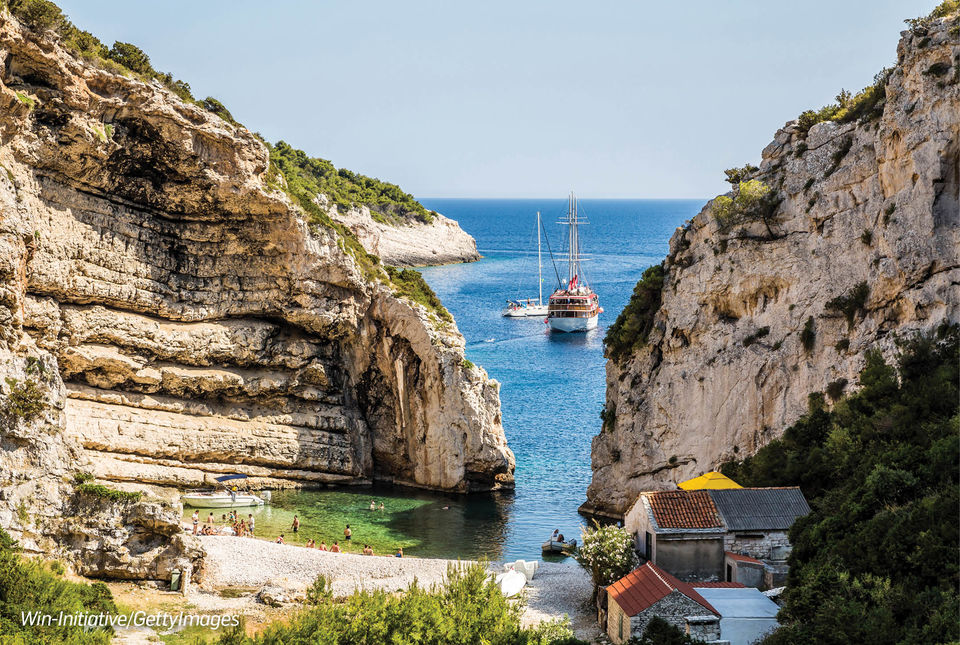On the Dalmatian coast of the Adriatic Sea lies Korcula, the island that is beginning to get attention from global wine connoisseurs and culinary enthusiasts.
By Abhilasha Ojha

When Frano Banicevic pours Plavac Toreta 2015, a fairly refined wine, it seems like drops of garnet dance and twirl in my glass. “Life,” he says, smiling intently, “is useless without wine.” This is the sixth wine that we’re tasting as part of Korcula’s wine tour (pronounced Kor-chu-la), a four-hour, must-do expedition organised by Korkyra Info Agency (korkyra.info) that takes you around the island, one of the prettiest in Croatia.
It is a fascinating journey to understand Croatian wines, the commodity that is gradually getting noted in markets including the US, Australia,China, Japan, and parts of Europe. “Every wine,” Banicevic tells us, serving us a platter of home-made cheese, “is different vintage. There is no cut-and-paste job in wines. Each wine,” he says, pouring his next creation, Posip Special 2016, “has to be created differently.”
By now, there are three cats vying for our attention in Toreto’s wine tasting room, which also houses a vintage museum of sorts showcasing old tools of the trade—vine cutters, grape crushers, wooden barrels, grape seed sifters, transfer wagons, field tools, among other objects. “These,” says Banicevic, pointing to these objet d’art, “were used by my great grandfather, and I bet he did more wine production with these than what modern wineries do with technologically-savvy tools.” What may have been the secret, I ask, biting into delicious cheddar cheese, as one of the attention seeking cats meow. “Ah,” Banicevic says, shrugging his shoulders, “it is passion.”

Toreta’s Posip collection is quite splendid. The straw-golden yellow-coloured wine leaves a thick trail in the glass given its richness. Harmonious, pleasant and intense on the palate, Posip, for the record, is considered the perfect culinary companion to fish, shellfish, and white meat dishes. The Toreta vineyards are located in Smokvica, one of the oldest villages in Korcula. This family owned wine brand—founded by Banicevic’s great grandfather almost five decades ago—is considered to be one of the earliest private wineries to bring out premium-quality Posip.
It produces roughly 40,000 bottles of wine per year, growing Posip, Rukatac, and Plavac. I realise that it is a matter of great pride that we taste Posip in Korcula, the birthplace of this wine. There is such growing interest in this wine globally that it is now protected by the Croatian law to ensure best practices in cultivation of this particular type. Yes, feeling a sense of gratitude for this experience is inadvertent. Croatia’s beauty was evident from the moment our flight touched down in Split, the second-largest city in Croatia with its rich history, majestic buildings, beautiful beaches, and gorgeous sunsets. Our trip to Croatia, a reunion of sorts for two old school mates and I, included not just Split, but also Trogir, Korcula, and Dubrovnik.

While all the cities have their charm, it is the wine paradise of Korcula, inarguably Croatia’s most beautiful and greenest islands, which takes my breath away. From the spectacular sunsets to the high quality wine that the island produces, Korcula is the destination to visit. On a wine map, the island is divided into four sections: Lumbarda, Cara, Smokvica, and Blato, each known for its particular grapes, vineyards, and family-run wineries. While the central region of the island grows Posip and Rukatac, on the eastern tip of the island grows Grk, another white grape only found in the village of Lumbarda.
Tipple tourism is at its best here, with the tourism board and private players offering curated wine tours to travellers willing to explore the island. We see the entire island on a self-drive tour, with stops at Smokvica and Blato, before heading to Korcula to finish our trip in style with a three-course lunch paired with different kinds of wines, red, white, and dessert rosé. After Toreto, our next stop, was Blato, a gorgeous town with Baroque mansions, Romanesque-Gothic-style churches, and avenues of lime trees that lend a splendid fragrance to the air.

At Blato 1902’s wine tasting room (blato1902.hr)—a company-run winery (unlike Toreto)—we taste a very elegant rosé with a delicious aroma, full of fruity character and fl oral fragrance. Soft on the palate, this is a wine best served chilled and paired with grilled fish, light pasta, and homemade macaroni.
Blato 1902, we are told, is one of the biggest producers of wine today. “Our forte lies in producing only premium wines. Going forward, we will continue to grow in exports,” says Diana Petcovic, a senior official of Blato 1902, while filling our glasses with a wonderful red. Blato 1902 is a growing company, which produces, besides wines, its range of olive oils, and figs, and also has restaurants and catering businesses. Our wine tasting experience, that includes freshly baked bread and freshly-pressed olive oil, its jade colour almost sparkling as Petcovic pours some in a pristine white, ceramic plate, is subliminal.

It is in Korcula, in the heart of the numerous vineyards, where some of the best wines are produced, that one understands why wine tours have become so relevant. In a glass of wine, there’s much more than just that—you are, obliviously, sipping on history, immersing yourself in local traditions, and tasting secrets of vino-making that have been passed down from generation to generation. What makes the afternoon a memorable experience for us is the lunch at Chakula Macaruni & Wine House (Ulica od Teatra 12; +385-99/291-5443) in the majestic centre of Korcula town—a mini-fortress, with cobbled pathways, limestone buildings, and Baroqueinspired churches.

Some art historians believe Korcula was the home of traveller-merchant Marco Polo (Venice, however, disputes this claim) and Kanavalic Place (where we stay) used to be, in its original avatar, the home of Petar Kanavelic, a 16th century poet. The three-course lunch in Chakula—each course is paired with a different wine, of course—is an invitation to gastronomical luxury and history. The newly opened restaurant showcases a variety of dishes, especially a few that feature the traditional skill of making ‘makaruni’ or macaroni. The chefs tell us the recipe is more than 400 years old and the cooking technique has been passed down generations in the Korcula village of Žrnovo.

My personal favourite is a bowl of freshly-made pasta with meat, drizzled with fresh olive oil, Croatian sea salt, indigenous herbs, and coarsely ground pepper. It’s paired with a ruby red Dingac, another well-known Croatian wine. The pleasure of sipping a top-rated wine with food born from tradition, is a gourmet symphony.


